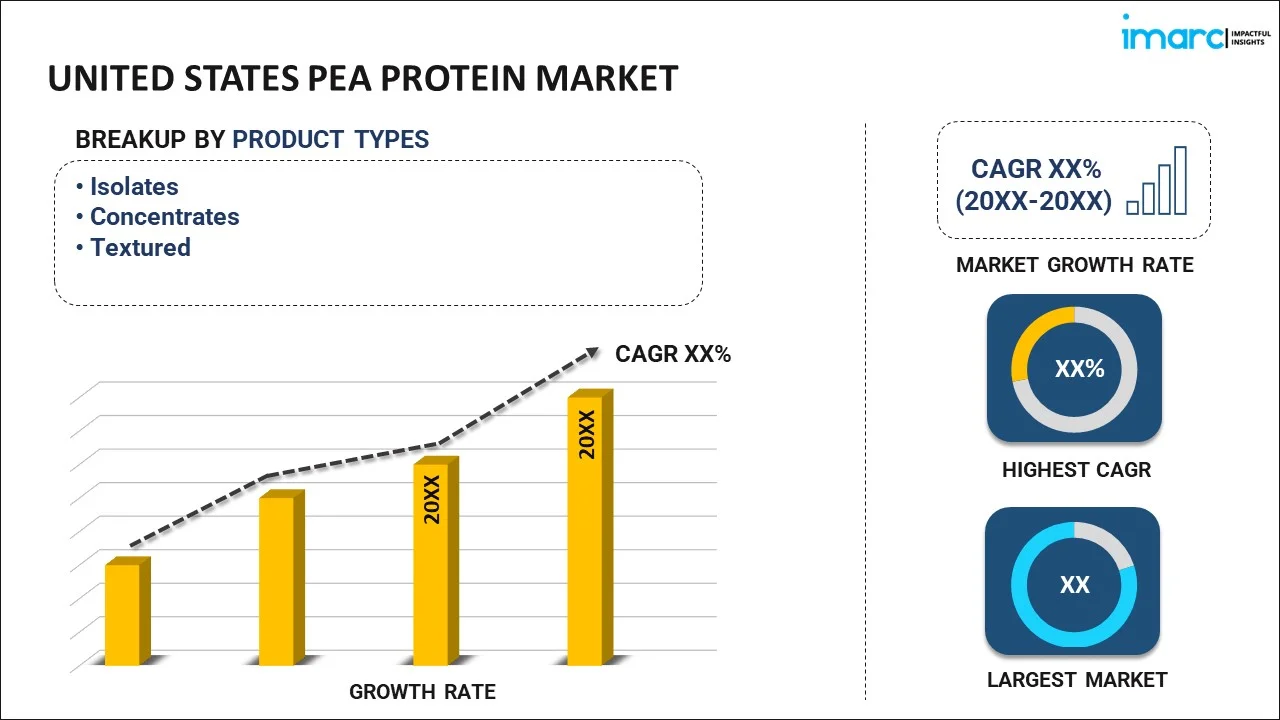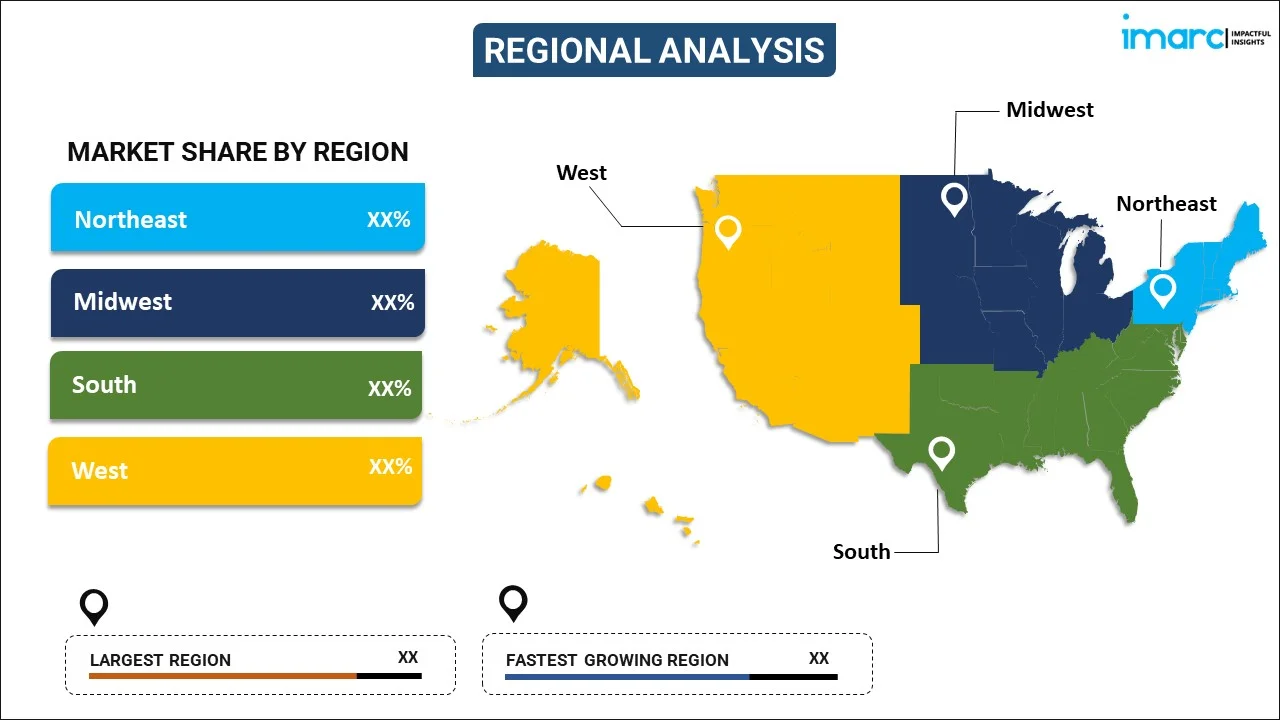
United States Pea Protein Market Report by Product Type (Isolates, Concentrates, Textured), Application (Dietary Supplements, Bakery Products, Meat Substitutes, Beverages, and Others), End User (Retail, Institutional), and Region 2025-2033
Market Overview:
The United States pea protein market size reached USD 273 Million in 2024. Looking forward, IMARC Group expects the market to reach USD 413 Million by 2033, exhibiting a growth rate (CAGR) of 4.7% during 2025-2033. The growing shift towards plant-based diets, the increasing awareness of the environmental impact of animal agriculture, the rising emphasis on health and wellness, the escalating focus on clean-label and natural ingredients, the increasing number of individuals adopting vegan and vegetarian lifestyles, and the expanding food and beverage industry applications are some of the factors propelling the market.
|
Report Attribute
|
Key Statistics
|
|---|---|
|
Base Year
|
2024 |
|
Forecast Years
|
2025-2033
|
|
Historical Years
|
2019-2024
|
| Market Size in 2024 | USD 273 Million |
| Market Forecast in 2033 | USD 413 Million |
| Market Growth Rate (2025-2033) | 4.7% |
Pea protein is a high-quality plant-based protein derived from yellow peas (Pisum sativum). It has gained significant popularity as a nutritional supplement and ingredient in various food and beverage products. The extraction process involves cleaning, milling, and isolating the protein from dried peas, resulting in pea protein isolates or concentrates. One of the key attributes of pea protein is its rich amino acid profile, including essential amino acids that the human body cannot produce naturally. This makes pea protein a valuable source of protein for those seeking plant-based or allergen-friendly alternatives. It is often recognized for being gluten-free, dairy-free, and hypoallergenic, making it suitable for individuals with dietary restrictions or sensitivities. Its versatility extends to applications in the food industry, where it is commonly used in plant-based meat alternatives, dairy substitutes, energy bars, snacks, and baked goods. Pea protein's neutral flavor allows for seamless integration into various products without compromising taste. Beyond its nutritional content, pea protein is valued for its sustainability. Peas are nitrogen-fixing plants, which means they can enrich the soil with nitrogen, reducing the need for synthetic fertilizers. The cultivation of peas has a lower environmental footprint compared to certain animal-based protein sources, aligning with the increasing emphasis on sustainable and eco-friendly food choices. As consumers increasingly adopt plant-based diets and prioritize health-conscious and sustainable choices, pea protein has become a prominent player in the broader landscape of alternative proteins. Its ability to cater to diverse dietary needs and serve as a viable protein source in an array of food applications positions pea protein as a valuable and versatile ingredient in the evolving world of plant-based nutrition.
United States Pea Protein Market Trends:
The market in the United States is primarily driven by the rising demand for plant-based protein alternatives. With an increasing number of consumers adopting flexitarian, vegetarian, and vegan lifestyles, there's a growing interest in plant-based protein sources, including pea protein. As individuals seek healthier and more sustainable dietary options, pea protein emerges as a versatile and nutritious choice, supporting the overall market expansion. Furthermore, health and wellness trends contribute significantly to the market growth. Consumers are becoming more conscious of their dietary choices, focusing on clean-label products and incorporating plant-based proteins into their diets. Pea protein's allergen-friendly profile, gluten-free nature, and balanced amino acid composition make it an attractive option for health-conscious individuals seeking a nutritious and sustainable protein source. Besides, the escalating popularity of pea protein is further amplified by its application in various food and beverage products. The versatility of pea protein isolates and concentrates allows for integration into an extensive range of products, including plant-based burgers, dairy alternatives, protein bars, and nutritional supplements. As the demand for these products rises, so does the demand for pea protein as a key ingredient, driving market growth. In response to the increasing interest in sustainable and environmentally friendly products, pea protein aligns with consumers' values. Peas are nitrogen-fixing plants, promoting soil health and requiring less synthetic fertilizers, contributing to a lower environmental impact compared to certain animal-based proteins. Sustainability considerations are becoming more influential in purchasing decisions, boosting the appeal of pea protein among environmentally conscious consumers. Additionally, the rising investments and collaborations in the food industry are strengthening the market. Companies are investing in research and development, expanding production capacities, and collaborating to create innovative pea protein-based products. This commitment to product innovation enhances the market's competitiveness and broadens the range of pea protein offerings available to consumers, fueling the market growth.
United States Pea Protein Market Segmentation:
IMARC Group provides an analysis of the key trends in each segment of the market, along with forecasts at the country level for 2025-2033. Our report has categorized the market based on product type, application, and end user.
Product Type Insights:

- Isolates
- Concentrates
- Textured
The report has provided a detailed breakup and analysis of the market based on the product type. This includes isolates, concentrates, and textured.
Application Insights:
- Dietary Supplements
- Bakery Products
- Meat Substitutes
- Beverages
- Others
A detailed breakup and analysis of the market based on the application have also been provided in the report. This includes dietary supplements, bakery products, meat substitutes, beverages, and others.
End User Insights:
- Retail
- Institutional
The report has provided a detailed breakup and analysis of the market based on the end user. This includes retail and institutional.
Regional Insights:

- Northeast
- Midwest
- South
- West
The report has also provided a comprehensive analysis of all the major regional markets, which include Northeast, Midwest, South, and West.
Competitive Landscape:
The market research report has also provided a comprehensive analysis of the competitive landscape. Competitive analysis such as market structure, key player positioning, top winning strategies, competitive dashboard, and company evaluation quadrant has been covered in the report. Also, detailed profiles of all major companies have been provided.
United States Pea Protein Market Report Coverage:
| Report Features | Details |
|---|---|
| Base Year of the Analysis | 2024 |
| Historical Period | 2019-2024 |
| Forecast Period | 2025-2033 |
| Units | Million USD |
| Scope of the Report | Exploration of Historical and Forecast Trends, Industry Catalysts and Challenges, Segment-Wise Historical and Predictive Market Assessment:
|
| Product Types Covered | Isolates, Concentrates, Textured |
| Applications Covered | Dietary Supplements, Bakery Products, Meat Substitutes, Beverages, Others |
| End Users Covered | Retail, Institutional |
| Regions Covered | Northeast, Midwest, South, West |
| Customization Scope | 10% Free Customization |
| Post-Sale Analyst Support | 10-12 Weeks |
| Delivery Format | PDF and Excel through Email (We can also provide the editable version of the report in PPT/Word format on special request) |
Key Questions Answered in This Report:
- How has the United States pea protein market performed so far and how will it perform in the coming years?
- What has been the impact of COVID-19 on the United States pea protein market?
- What is the breakup of the United States pea protein market on the basis of product type?
- What is the breakup of the United States pea protein market on the basis of application?
- What is the breakup of the United States pea protein market on the basis of end user?
- What are the various stages in the value chain of the United States pea protein market?
- What are the key driving factors and challenges in the United States pea protein?
- What is the structure of the United States pea protein market and who are the key players?
- What is the degree of competition in the United States pea protein market?
Key Benefits for Stakeholders:
- IMARC’s industry report offers a comprehensive quantitative analysis of various market segments, historical and current market trends, market forecasts, and dynamics of the United States pea protein market from 2019-2033.
- The research report provides the latest information on the market drivers, challenges, and opportunities in the United States pea protein market.
- Porter's five forces analysis assist stakeholders in assessing the impact of new entrants, competitive rivalry, supplier power, buyer power, and the threat of substitution. It helps stakeholders to analyze the level of competition within the United States pea protein industry and its attractiveness.
- Competitive landscape allows stakeholders to understand their competitive environment and provides an insight into the current positions of key players in the market.
Need more help?
- Speak to our experienced analysts for insights on the current market scenarios.
- Include additional segments and countries to customize the report as per your requirement.
- Gain an unparalleled competitive advantage in your domain by understanding how to utilize the report and positively impacting your operations and revenue.
- For further assistance, please connect with our analysts.
 Request Customization
Request Customization
 Speak to an Analyst
Speak to an Analyst
 Request Brochure
Request Brochure
 Inquire Before Buying
Inquire Before Buying




.webp)




.webp)












